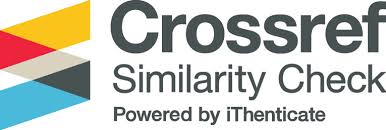Antihyperpigmentation Potential of Michelia Alba Leaves: In Silico Study
Abstract
Michelia alba empirically provides a youthful effect associated with the formation of melanin or skin pigment by tyrosinase enzyme. However, the excessive formation of melanin results in hyperpigmentation and various dermatological disorders such as freckles, melasma, and age spots. Synthetic antihyperpigmentations, which suppress melanin production, have been widely used, but have shown adverse side effects. This study aims to examine the potential of M. alba as a natural antihyperpigmentation agent.
The in-silico research was conducted on the compounds contained in M. alba leaves through molecular docking against tyrosinase enzyme (PDB ID: 1BUG) followed by analysis of physicochemical properties and absorption, distribution, metabolism, excretion, and toxicity profiles (ADMET).
The molecular docking results of cis-linalool oxide, trans-linalool oxide, linalool, β-elemene, α-humulene, and nerolidol in M. alba leaves against 1BUG indicated that nerolidol, α-humulene, and β-elemene showed lower docking scores than kojic acid and hydroquinone as controls. Nerolidol, α-humulene, and β-elemene interacted with 1BUG via hydrogen bonding, Van der Walls, and alkyl/π-alkyl and π-π stacking interactions. All compounds did not violate Lipinski and Veber rules based on the analysis of physicochemical properties. All compounds also had good absorption, distribution, metabolism, excretion, and toxicity profiles based on the parameters in each of these evaluations in the ADMET analysis.
References
[2]. Wang, H. -M., Chen, C. -Y., Chen, C. -Y., Ho, M. -L., Chou, Y. -T., Chang, H. -C., Lee, C. -H., Wang, C. -Z., Chu, I-M. 2010. (-)-N-Formylanonaine from Michelia Alba as a humantyrosinase inhbitor and antioxidant. Bioorg. Med. Chem. 18: 5241-5247.
[3]. Chiang, H. -M., Chen, H. -C., Lin, T. -J., Shih, I-C., Wen, K. -C. 2012. Michelia Alba extract attenuates UVB-induced expression of matrix metalloproteinased via MAP kinase pathway in human dermal fibroblast. Food Chem. Toxicol. 50: 4260-4269.
[4]. Chávez-Béjar, M. I., Balderas-Hernandez, V. E., Gutiérrez-Alejandre, A., Martinez, A., Bolívar, F., Gosset, G. 2013. Metabolic engineering of Escherichia coli to optimize melanin synthesis from glucose. Microb. Cell Factories. 12: 108.
[5]. Jugreet, B. L., Ibrahime, S. K., Zengin, G., Abdallah, H. H., Mahomoodally, M. F. 2021. GC/MS Profiling, in vitro and in silico pharmacological screening and principal component analysis of essential oils from three exotic and two endemic plants from Mauritius. Chem. Biodivers. 18: e2000921.
[6]. Owolabi, J. O., Fabiyi, O. S., Adelakin, L.A., Ekwerike, M. C. 2020. Effects of skin lightening cream agents – hydroquinone and kojic Acid, on the skin of adult female experimental rats. Clin. Cosmet. Investig. Dermatol. 13: 283–289.
[7]. Zhao, N., Su, X., Wang, Y., Chen, J., Zhuang, W. 2020. Traditional chinese herbal medicine for whitening. Nat. Prod. Commun. 15: 1-12.
[8]. Kiss, R., Sandor, M., Szalal, F. A. 2012. http://Mcule.com: A public web service for drug discovery. J. Cheminformatics. 4: P17.
[9]. Daina, A., Michielin, O., Zoete, V. 2016. SwissADME: A free web tool to evaluate pharmacokinetics, drug-likeness and medicinal chemistry friendliness of small molecules. Sci. Rep. 7: 42717.
[10]. Pires, D. E. V., Blundell, T. L.. Ascher, D. B. 2015. pkCSM: Predicting small-molecule pharmacokinetic and toxicity properties using graph-based signatures. J. Med. Chem. 58: 4066–4072.
[11]. Ueyama, Y., Hashimoto, S., Nii, H., Furukawa, K. 1992. The chemical composition of the flower oil and the leaf oil of Michelia alba D.C. J. Essent. Oil Res. 4: 15-23.
[12]. Morris, G. M., Huey, R., Lindstrom, W., Sanner, M. F., Belew, R. K., Goodsell, D. S., Olson, A. J. 2009, AutoDock4 and AutoDockTools4: Automated docking with selective receptor flexibility. J. Comput. Chem. 30: 2785–2791.
[13]. Rudarapal, M., Chetia, D. 2020. Virtual screening, molecular docking and QSAR studies in drug discovery and development programme. J. Drug Deliv. Ther. 10:225-233.
[14]. Maia, E. H. B., Assis, L. C., de Oliveira, T. A., da Silva, A. M., Taranto, A. G. 2020. Structure-based virtual screening: From classical to artificial intelligence. Front. Chem. 8: 343.
[15]. Elfiky, A. A., Mahdy, S. M., Elshemey, W. M. 2017. Quantitative structure-activity relationship and molecular docking revealed a potency of anti-hepatitis C virus drugs against human corona viruses. J. Med. Virol. 89: 1040-1047.
[16]. da Silva, A. P., Silva, N. F., Andrade, E. H. A., Gratieri, T., Setzer, W. N., Maia, J. G. S., da Silva, J. K. R. 2017. Tyrosinase inhibitory activity, molecular docking studies and antioxidant potential of chemotypes of Lippia origanoides (Verbenaceae) essential oils. Plos ONE. 12: e0175598.
[17]. Capetti, F., Tacchini, M., Marengo, A., Cagliero, C., Bicchi, C., Rubiolo, P., Sgorbini, B. 2021. Citral-containing essential oils as potential tyrosinase inhibitors: A bio-guided fractionation Approach. Plants. 10: 969.
[18]. Lipinski, C. A. 2000, Drug-like properties and the causes of poor solubility and poor permeability. J. Pharmacol. Toxicol. Methods. 44: 235–249.
[19]. Lipinski, C. A., Lombardo, F., Dominy, B. W., Feeney, P. J. 1997. Experimental and computational approaches to estimate solubility and permeability in drug discovery and development settings. Adv. Drug Deliv. Rev. 23 (SUPPL.): 3–25.
[20]. Veber, D. F., Johnson, S. R., Cheng, H.-Y., Smith, B. R., Ward, K. W., Kopple, K. D. 2002, Molecular properties that influence the oral bioavailability of drug candidates. J. Med. Chem. 45: 2615–2623.
[21]. Chander, S., Tang, C. R., Al-Maqtari, H. M., Jamalis, J., Penta, A., Ben Hadda, T., Sirat, H. M., Zheng, Y-T., Sankaranarayanan, M. 2017. Synthesis and study of anti-HIV-1 RT activity of 5-benzoyl-4-methyl-1,3,4,5- tetrahydro-2H-1,5-benzodiazepin-2-one derivatives. Bioorg. Chem. 72: 74-79.
[22]. Label Review Manual - Chapter 7: Precautionary Statements, EPA Washington DC, 2018. OPP Label Review Manual - Chapter 7 (epa.gov). diakses tanggal 06 Maret 2022.













